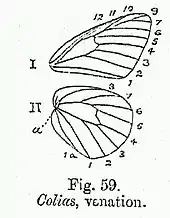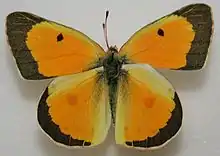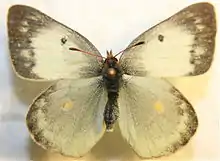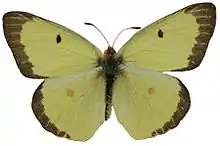Colias
Colias is a genus of butterflies in the family Pieridae. They are often called clouded yellows in the Palearctic and sulphurs (a name also used for other coliadine genera) in North America. The closest living relative is the genus Zerene,[4] which is sometimes included in Colias.

| Clouded yellows | |
|---|---|
_Colias_hyale_-_Novy_Jicin_Moravie_Czech_Republic_-_male_dorsal.jpg.webp) | |
| Colias hyale type species for the genus | |
| Scientific classification | |
| Domain: | Eukaryota |
| Kingdom: | Animalia |
| Phylum: | Arthropoda |
| Class: | Insecta |
| Order: | Lepidoptera |
| Family: | Pieridae |
| Tribe: | Coliadini |
| Genus: | Colias Fabricius, 1807 |
| Type species | |
| Papilio hyale | |
| Synonyms | |
| |
This genus occurs throughout the Holarctic, including the arctic regions. They are also found in South America, Africa, China and India. Their caterpillars feed on certain Fabaceae, for example vetches (Vicia). While most are thus beneficial by keeping weeds at bay, some occasionally become nuisance pests on crops like alfalfa. In some species, the wings of males have brilliant ultraviolet reflection, while those of females do not.[5][6] Adults of both sexes have various colour forms.
Most if not all species of this genus, as usual for Coliadinae, do not sequester toxins or other noxious compounds from their food plants. They are therefore a well-loved prey item of insectivores as compared to Pieris of the related Pierinae. They make up this disadvantage by being more nimble and better able to evade attacks by would-be predators.[7]
Notable lepidopterologists who did many studies on this genus included Julius Röber, J. Malcolm Fawcett, George B. Johnson and Henry Rowland-Brown.
Systematics
Hybridization runs rampant in these polytypic and clinal[8] butterflies, confounding molecular phylogenetics studies. In general, cladistic analyses of only one type of data (particularly mtDNA sequences) cannot be considered reliable. Regardless, the evolutionary distance within some "species" is so large that cryptic speciation rather than (or in addition to) interbreeding seems to be the cause. For example, the Beringian populations traditionally assigned to the northern clouded yellow (C. hecla) could warrant recognition as a species; hybridization between North American and Asian populations seems to have played a role in their evolution, but as a whole they appear to be a rather old and distinct lineage.[9]
.JPG.webp)
Species
Listed alphabetically:[10]
- Colias adelaidae Verhulst, 1991
- Colias aegidii Verhulst, 1990
- Colias alfacariensis Ribbe, 1905 – Berger's clouded yellow
- Colias alexandra W. H. Edwards, 1863 – Queen Alexandra's sulphur, Alexandra sulfur, or ultraviolet sulfur
- Colias alpherakii Staudinger, 1882
- Colias aquilonaris Grum-Grshimailo, 1899
- Colias arida Alphéraky, 1889
- Colias audre (Hemming, 1933)
- Colias aurorina Herrich-Schäffer, 1850 – Greek clouded butterfly or dawn clouded yellow
- Colias baeckeri Kotzsch, 1930
- Colias behrii W. H. Edwards, 1866 – Behr's sulphur or Sierra green sulfur
- Colias berylla Fawcett, 1904 – Everest clouded yellow
- Colias canadensis Ferris, 1982 – Canada sulphur
- Colias caucasica Staudinger, 1871 – Balkan clouded yellow
- Colias chippewa W. H. Edwards, 1872 – heath sulphur
- Colias chlorocoma Christoph, 1888
- Colias christina W. H. Edwards, 1863 – Christina sulphur
- Colias christophi Grum-Grshimailo, 1885
- Colias chrysotheme (Esper, 1781) – lesser clouded yellow
- Colias cocandica Erschoff, 1874
- Colias croceus (Geoffroy, 1785) – dark clouded yellow or common clouded yellow
- Colias dimera Doubleday, 1847 – dimera sulphur
- Colias diva Grum-Grshimailo, 1891
- Colias dubia Fawcett, 1906 – dwarf clouded yellow
- Colias electo (Linnaeus, 1763) – African clouded yellow
- Colias elegans Schultz, 1904
- Colias elis Strecker, 1885 (often included in C. meadii; paraphyletic?)
- Colias eogene C. & R. Felder, 1865 – fiery clouded yellow
- Colias erate (Esper, 1805) – eastern pale clouded yellow
- Colias erschoffi Alphéraky, 1881
- Colias eurytheme Boisduval, 1852 – orange sulphur, alfalfa butterfly
- Colias euxanthe C. & R. Felder, 1865 – Puno clouded yellow
- Colias felderi Grum-Grshimailo, 1891
- Colias fieldii Ménétriés, 1855
_Colias_myrmidone_myrmidone_-_Star%C3%A1_Tur%C3%A1_Slovaquie_-_male.jpg.webp)
- Colias flaveola Blanchard, 1852 – flaveola clouded yellow
- Colias gigantea Strecker, 1900 – great (northern) sulphur
- Colias grumi Alpheraky, 1897
- Colias harfordii W. H. Edwards, 1877 – Harford's sulphur
- Colias hecla Lefèbvre, 1836 – northern clouded yellow, Greenland sulphur, or hecla sulphur (paraphyletic?)
- Colias heos (Herbst, 1792)
- Colias hofmannorum Eckweiler, 2000
- Colias hyale (Linnaeus, 1758) – pale clouded yellow
- Colias hyperborea Grum-Grshimailo, 1899
- Colias interior Scudder, 1862 – pink-edged sulphur
- Colias johanseni Troubridge & Philip, 1990 – Johansen's sulphur
- Colias krauthii Klots, 1935
- Colias lada Grum-Grshimailo, 1891
- Colias ladakensis Felder & Felder, 1865 – Ladakh clouded yellow
- Colias leechi Grum-Grshimailio, 1893
- Colias lesbia (Fabricius, 1775) – Lesbia clouded yellow
- Colias libanotica Lederer, 1858 (sometimes included in C. aurorina)
- Colias marcopolo Grum-Grshimailo, 1888
- Colias marnoana Rogenhofer, 1884
- Colias meadii W. H. Edwards, 1871 – Mead's sulphur
- Colias montium Oberthür, 1886
- Colias mukana Berger, 1981
- Colias myrmidone (Esper, 1781) – Danube clouded yellow
- Colias nastes Boisduval, 1834 – Labrador sulphur
- Colias nebulosa Oberthür, 1894
- Colias nilagiriensis Felder, C & R Felder, 1859
- Colias nina Fawcett, 1904 – Fawcett's clouded yellow
- Colias occidentalis Scudder, 1862 – western sulphur or golden sulfur
- Colias palaeno (Linnaeus, 1761) – moorland clouded yellow, Arctic sulphur, palaeno sulphur or pale Arctic clouded yellow
- Colias pelidne Boisduval & Le Conte, 1829 – blueberry sulphur or pelidne sulphur
- Colias phicomone (Esper, 1780) – mountain clouded yellow
- Colias philodice Godart, 1819 – common sulphur, clouded sulphur
- Colias ponteni Wallengren, 1860
- Colias pseudochristina Ferris, 1989
- Colias regia Grum-Grshimailo, 1887
- Colias romanovi Grum-Grshimailo, 1885
- Colias sagartia Lederer, 1869
- Colias scudderii Reakirt, 1865 – willow sulphur
- Colias shahfuladi Clench & Shoumatoff, 1956
- Colias sieversi Grum-Grshimailo, 1887
- Colias sifanica Grum-Grshimailo, 1891
- Colias staudingeri Alphéraky, 1881
- Colias stoliczkana Moore, 1882 – orange clouded yellow
- Colias tamerlana Staudinger, 1897
- Colias thisoa Ménétriés, 1832
- Colias thrasibulus Fruhstorfer, 1908 – lemon clouded yellow
- Colias thula Hovanitz, 1955 – Thula sulphur
- Colias tibetana Riley, 1922
- Colias tyche (Böber, 1812) – pale Arctic clouded yellow, Arctic green sulphur, or Booth's sulphur
- Colias viluiensis (Ménétriés, 1859)
- Colias wanda Grum-Grshimaïlo, 1907
- Colias wiskotti Staudinger, 1882
Distinguishing characteristics
Colias are usually some shade of yellow, orange or white. Their uppersides feature black borders (usually solid in males, often with pale spots in females). They always perch with wings closed, but upperside pattern may be seen faintly through the wing, or glimpsed in flight.[11]
Gallery

_Colias_christophi_-_Tadjikistan_Russie_-_male_dorsal.jpg.webp) Colias christophi, male
Colias christophi, male_Colias_myrmidone_myrmidone_-_Star%C3%A1_Tur%C3%A1_Slovaquie_-_male_dorsal.jpg.webp) Colias myrmidone, male
Colias myrmidone, male Colias eurytheme, male
Colias eurytheme, male_Colias_croceus_-_Durfort_Tarn_France_-_male_dorsal.jpg.webp) Colias croceus, male
Colias croceus, male_Colias_croceus_f._helice_-_Wyzyna%252C_Okolice_Polska_-_male_dorsal.jpg.webp) Colias croceus f. helice
Colias croceus f. helice_Colias_chrysotheme_chrysotheme_-_%C3%89rd_Hongrie_-_male_dorsal.jpg.webp) Colias chrysotheme, male
Colias chrysotheme, male Colias philodice, female
Colias philodice, female Colias philodice f. alba, female
Colias philodice f. alba, female Colias philodice, male
Colias philodice, male_Colias_alfacariensis_-_Novy_Jicin%252C_Moravie_Tch%C3%A9quie_-_female_dorsal.jpg.webp) Colias alfacariensis, female
Colias alfacariensis, female_Colias_hyale_-_Novy_Jicin_Moravie_Czech_Republic_-_male_dorsal.jpg.webp) Colias hyale, male
Colias hyale, male_Colias_hyale_-_Novy_Jicin_Moravie_Czech_Republic_-_female_dorsal.jpg.webp) Colias hyale, female
Colias hyale, female_Colias_palaeno_-_Majdan_Kasztela%C5%84ski_Pologne_-_male_dorsal.jpg.webp) Colias palaeno, male
Colias palaeno, male Colias palaeno, female
Colias palaeno, female_Colias_Phicomone_-_Pic_d'Aneto_Espagne_-_male_dorsal.jpg.webp) Colias phicomone, male
Colias phicomone, male_Colias_Phicomone_-_Sestriere_Italia_-_female_ventral.jpg.webp) Colias phicomone, female
Colias phicomone, female
References
- Josef Grieshuber & Gerardo Lamas (2007). "A synonymic list of the genus Colias Fabricius, 1807 (Lepidoptera: Pieridae)" (PDF). Mitteilungen der Münchner Entomologischen Gesellschaft. 97: 131–171. Archived from the original (PDF) on 2016-03-04. Retrieved 2013-05-09.
- Bjorn Petersen, 1963. The male genitalia of some Colias species.Journal of Research on the Lepidoptera 1: 135-156. Archived 2017-06-03 at the Wayback Machine
- Lucien A Berger, 1986 Systématique du genre Colias F: Lepidoptera-Pieridae Bruxelles: Imprimerie des Sciences, 1986.
- Andrew V. Z. Brower (November 16, 2006). "Coliadinae". Tree of Life Web Project. Retrieved August 7, 2008.
- M. L. Lim & D. Li (2005). "Extreme ultraviolet sexual dimorphism in jumping spiders (Araneae: Salticidae)". Biological Journal of the Linnean Society. 89 (3): 397–406. doi:10.1111/j.1095-8312.2006.00704.x.
- Andrew V. Z. Brower (November 16, 2006). "Colias". Tree of Life Web Project. Retrieved August 7, 2008.
- Robert B. Srygley & Joel G. Kingsolver (1998). "Red-wing blackbird reproductive behaviour and the palatability, flight performance, and morphology of temperate pierid butterflies (Colias, Pieris, and Pontia)". Biological Journal of the Linnean Society. 64 (1): 41–55. doi:10.1111/j.1095-8312.1998.tb01532.x.
- Paul C. Hammond, 1990 Patterns of geographic variation and evolution in polytypic butterflies Journal of Research on the Lepidoptera 29(1-2):54-76. Archived 2013-12-03 at the Wayback Machine
- Christopher W. Wheat & Ward B. Watt (2008). "A mitochondrial-DNA-based phylogeny for some evolutionary-genetic model species of Colias butterflies (Lepidoptera, Pieridae)". Molecular Phylogenetics and Evolution. 47 (3): 893–902. doi:10.1016/j.ympev.2008.03.013. PMID 18442929.
- Markku Savela. "Colias Fabricius, 1807". Lepidoptera and some other life forms.
- Brock, J.P. & Kaufman, K. Kaufman Field Guide to Butterflies of North America. Houghton Mifflin, 2003, p. 60.
Further reading
- Vladimir Lukhtanov & Alexander G. Lukhtanov, 1994 Die Tagfalter Nordwestasiens: (Lepidoptera, Diurna) V. Eitschberger ISBN 9783923807024
- Joseph T. Verhulst (English translation R. Leestmans, editing E. Benton and R. Leestmans), 2000 Les Colias du Globe translation Monograph of the genus Colias Keltern, Germany: Goecke & Evers ISBN 9783931374150
- Glassberg, Jeffrey Butterflies through Binoculars, The West (2001)
- Guppy, Crispin S. and Shepard, Jon H. Butterflies of British Columbia (2001)
- James, David G. and Nunnallee, David Life Histories of Cascadia Butterflies (2011)
- Pelham, Jonathan Catalogue of the Butterflies of the United States and Canada (2008)
- Pyle, Robert Michael The Butterflies of Cascadia (2002)
Colias "Le genre Colias" provides distribution information in French.
External links
- Colias images at Consortium for the Barcode of Life
- Images representing Colias at Encyclopedia of Life
- Euroleps via search, includes images
- Rusinsects Photos and text relating to Palaearctic species
- Die Gattung Colias von J. Fuchs
- Oleg Kosterin Images from Siberia
- Butterflies and Moths of North America
- Butterflies of America